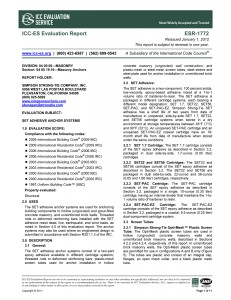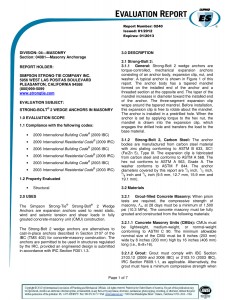Every building uses products that are not specifically covered in the building code. IBC Section 104.11 permits this if the “alternative material” is found to comply with the code intent by the building official after review of supporting information, such as research reports and tests.
Reviewing product data might be a challenge for some building departments, as they vary in size and expertise around the country. Some of the questions they might ask are:
1. What, if any, criteria was used to evaluate the product (e.g., test protocol, load rating methodology),
2. Was the criteria developed based on a single individual or a single company’s opinion or was there at least some involvement of others in the construction industry,
3. Are there any potential conflicts of interest in the parties wanting to use the product or the company who evaluated the product, and
4. Are there other tests or analyses that need to be completed prior to accepting the products use in the jurisdiction?
Product evaluation can sometimes be simple and other times it can be very complex. In some cases, the product’s performance may not have a big effect on the performance of a structure, while in other cases the product might greatly affect performance and may be a life safety concern. For those products that are structural elements, it is paramount to ensure that adequate analysis and testing have been completed in accordance with recognized, publically developed criteria to best ensure performance of these critical elements.
To facilitate and expedite the use of new, innovative products not covered by the code or products in which code requirements may be a bit ambiguous, or even for products that are covered by the code, several companies offer product evaluation reports, often called code reports. Code reports are different from a single building official product approval for a specific project in a specific location of a jurisdiction. Rather they are used in many jurisdictions by many users such as building officials, engineers, inspectors, and contractors.
Two of the main providers of product evaluation reports are the International Code Council Evaluation Service (ICC-ES) and the International Association of Plumbing and Mechanical Officials Uniform Evaluation Services (IAPMO UES). They are both accredited in accordance to ISO/IEC Guide 65 by the American National Standards Institute (ANSI) as Product Certification Agencies. Guide 65 requires impartial evaluation and certification of products, evaluation of products in accordance with relevant specified standards, documented procedures for the resolution of complaints/appeals/disputes received by the certification body, a directory of certified products, and regular review of their process.

ICC-ES and IAPMO UES typically develop acceptance or evaluation criteria in which they solicit written and/or verbal input from stakeholders in the affected industry so as not to rely on the opinions of only a few people on whether a product meets code intent. In addition, these companies require that an independent third party test lab performs or witnesses the product tests and then writes, seals and signs the product test reports. They also inspect the quality control process of the product manufacturer to ensure the manufacturer is continuing to fabricate the same product(s) for which the review was performed.

There are a lot of steps involved in a product evaluation, but they are necessary to provide confidence that the product was properly tested, adequately reviewed, and that it was evaluated to publically developed criteria. It’s crucial for an adequate system be in place to ensure proper evaluation of products to minimize the safety risk to the public.
(ANSI Accreditation links for ICC-ES and IAPMO UES)
Have you used code reports in your practice? Have you been able to participate in the ICC-ES and/or IAPMO UES Evaluation Committee public hearings to give input on the acceptance criteria for structural products? Let me know in the comments.
– Paul
What are your thoughts? Visit the blog and leave a comment!



The use of innovative materials and products would be easier to implement if the building codes included universal performance requirements for systems and components not explicitly covered. Some areas of the code have improved in this aspect over the past few cycles and upcoming cycles are promising, however there always seems to be gaping holes and questions whenever something really new comes on the scene.
Fantastic ideas ! I am thankful for the specifics – Does someone know where my business might acquire a template NJ DoT L-8 example to complete ?
Hello LindaWando390. my work colleague located a blank a form form at this site
http://goo.gl/9b8vpZ